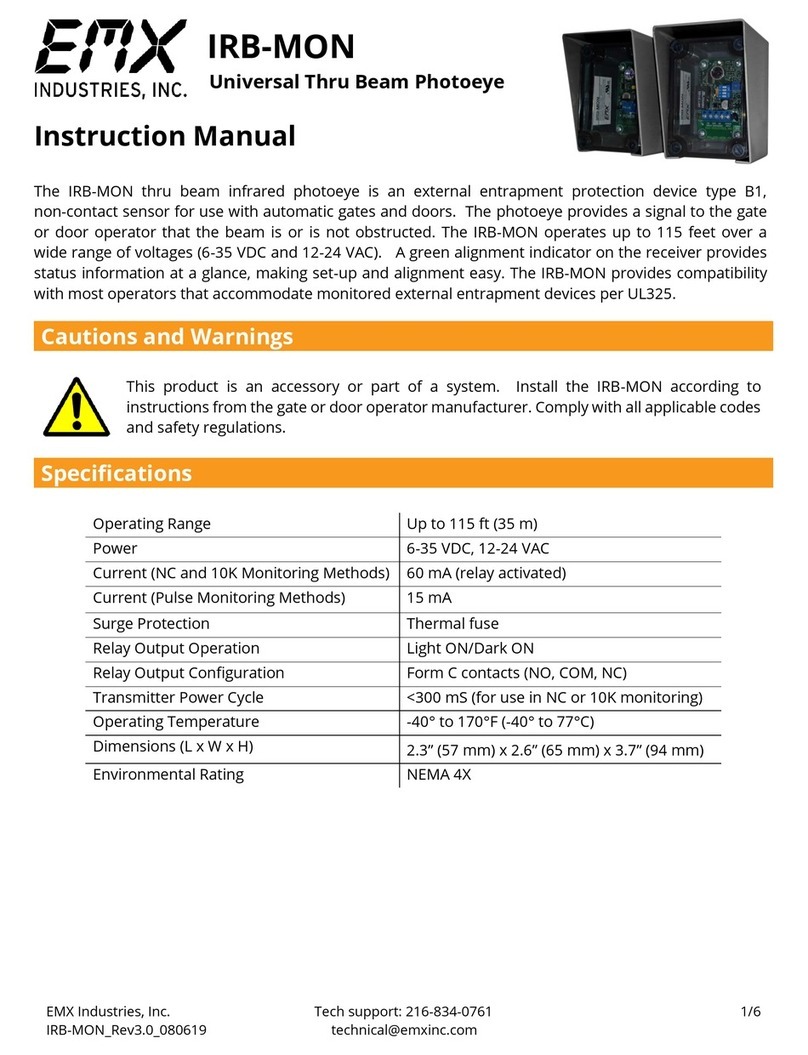EMX Industries UVX-300 User manual

U
UV
VX
X-
-3
30
00
0
L
Lu
um
mi
in
ne
es
sc
ce
en
nc
ce
e
s
se
en
ns
so
or
r
Operating Instructions

UVX-300 Operating Instructions 2
Document no. 10010104
CAUTION AND WARNING
CAUTION AND WARNINGCAUTION AND WARNING
CAUTION AND WARNING
CAUTION:
CAUTION: CAUTION:
CAUTION: The discrete output must not be connected to outputs from other sensors (i.e. outputs
from multiple sensors must not be connected in parallel). Parallel connections may
damage sensor output circuitry.
IMPORTANT:
IMPORTANT:IMPORTANT:
IMPORTANT:
This product is an accessory or part of a system. Always read and follow the manufacturer’s
instructions for the equipment before connecting this product. Comply with all applicable codes and
safety regulations. Failure to do so may result in damage, injury or death.
Langue Française
Langue FrançaiseLangue Française
Langue Française
Attention:
Attention:Attention:
Attention:
• La LED UV rayonne la lumière UV intense lors du fonctionnement.
• N'examinez pas directement la lumière UV lors du fonctionnement de dispositif.
Ceci peut être nocif aux yeux, même pour la brève période due à la lumière UV intense.
• i le visionnement de la lumière UV est nécessaire, employez svp les verres filtrés UV pour
éviter des dommages d'oeil par la lumière UV.
• Évitez l'exposition directe d'oeil à la lumière UV.
ubsistance hors de l'extension des enfants.
CERTIFICATION : CE, C A, UL
CERTIFICATION : CE, C A, ULCERTIFICATION : CE, C A, UL
CERTIFICATION : CE, C A, UL

UVX-300 Operating Instructions 3
Document no. 10010104
PRODUCT OVERVIEW
PRODUCT OVERVIEWPRODUCT OVERVIEW
PRODUCT OVERVIEW
The UVX 300 sensor effectively detects UV luminescent materials and markers. The modulated UV light
source in the UVX 300 is directed toward a target and the visible light, resulting from the fluorescence of the
material, is reflected back to the sensor. When the reflected light level exceeds the threshold the discrete
output changes state. Due to the fast response of the sensor, it is suitable for use in high-speed
applications. The 50mm lens accessory allows for very small spot size for fine resolution applications. The
sensor provides both an analog and a discrete output. The analog output signal has a 0 to 5 V range with
20mV resolution. A PLC or a computer can be used to process the analog output and monitor the status of
the discrete output signal.
The UVX 300 is a reliable, compact sensor with long range sensing capabilities. Two seven segment
displays provide visual representation of the relative intensity from 00 to 50. Easy two step sensitivity, and 3
LED intensity settings provide for flexible operation over wide range of distances and materials.
pecificat
pecificatpecificat
pecifications
ionsions
ions
UV light source 370nm UV LED, min.100,000 hours
LED Intensity 3 levels (low, medium and high)
Relative Intensity Display Range 00 to 50
ensitivity X1, X10
Detection Range Up to 36 inches (900mm)
witching Frequency 6 kHz
Brightness level Two 7 segment digits
Brightness threshold Two 7 segment digits
Analog Output 0 – 5 V (20mV resolution)
Digital Output Auto-Detect PNP / NPN
Extend Output Pulse 0 - 90 m (10 steps)
Output Function NO/NC selectable
On/Off Delay <200 u
ecurity Remote LOCK / UN-LOCK
Power indicator Green LED
Detect indicator Red LED
Programming indicator Yellow LED
ecurity Remote LOCK / UN-LOCK
Data retention EEPROM non—volatile memory
Dimensions 2.0”(51mm) x 2.4”(61mm) x 0.9”(23mm)
Weight 0.21 lbs. (95 g)
upply Voltage 10…24 VDC
Operating Current 60 mA
hort Circuit Protection Yes (Outputs)
Overload / Reverse Polarity Protection Yes ( upply Voltage)
Operating temperature -20°…50°C
torage temperature -20°C…70°C
Housing Metal alloy
Mechanical protection IP65 NOT FOR PRE URE WA HDOWN

UVX-300 Operating Instructions 4
Document no. 10010104
QUICK TART GUIDE
QUICK TART GUIDEQUICK TART GUIDE
QUICK TART GUIDE
1. The display range is 00 through 50. The decimal points indicate the LED intensity level. The RED
LED above the display indicates that the intensity level exceeds the threshold setting.
2. Connect cable to power supply observing correct polarity. Reference wiring diagram.
3. NOTE: The remote lock input, pin 5 on the connector (yellow wire), must be left unconnected or
pulled to ground to allow operation of keys on sensor.
4. Apply power; sensor will initialize and perform its power up sequence.
5. The relative intensity will be displayed. By aiming the sensor away from any objects the display will
indicate 00. Aim the sensor at your target or a white piece of paper and the display will indicate an
intensity measurement. Move the target further away from the sensor to decrease the intensity level.
6. Press and release either key located below the display to view the current threshold setting. While
the current threshold is shown on the display, press the + or – key to increase or decrease the
setting, then wait several seconds for the sensor to return to the normal intensity display mode.
7. User programmable parameters are discussed in detail in the following sections.
OPERATION
OPERATIONOPERATION
OPERATION
P
PP
Power up
ower upower up
ower up
Upon power up, the sensor initializes by turning on all segments on the display and sequencing
through red, yellow and green on the status LED located above the display.
Intensity display mode
Intensity display modeIntensity display mode
Intensity display mode
During normal operation the sensor display will indicate the relative intensity of a target within the
viewing area. The range of the relative intensity display is 00 through 50. The decimal points on the
display indicate the LED output intensity. No decimal points indicate low, one decimal point
indicates medium and two decimal points indicate high intensity.
Threshold
ThresholdThreshold
Threshold
When the relative intensity level exceeds the threshold setting the red status LED will turn on and the
discrete output will activate, indicating detection of the target. When the relative intensity level drops
below the threshold (as determined by the hysteresis setting), the red LED will extinguish and the
discrete output will de-activate. The threshold setting allows the user to select the detection level.
The default setting is 15.
While the current threshold is shown on the display, press the + or – key to increase or decrease the
setting, then wait several seconds for the sensor to return to the normal intensity display mode.
Local Lock
Local LockLocal Lock
Local Lock
The local lock feature allows the sensor to be locked out, preventing adjustments by unauthorized
personnel. To lock the sensor, press the P/
P/P/
P/-
--
- and T/+
T/+T/+
T/+ buttons for 3 seconds until LL
LLLL
LL is displayed. To
un-lock the sensor, press the T/+
T/+T/+
T/+ and P/
P/P/
P/-
--
- for 3 seconds until LL
LLLL
LL is not displayed. While the sensor is
locked, pressing either P/
P/ P/
P/-
--
- or T/+
T/+ T/+
T/+ will result in LL
LL LL
LL (L
LL
Local L
LL
Lock) indication on the display.

UVX-300 Operating Instructions 5
Document no. 10010104
Programmable Parameters
Programmable ParametersProgrammable Parameters
Programmable Parameters
All adjustments made to these parameters are stored in memory and are retained when power is removed.
To enter programming mode press and hold the P/
P/P/
P/-
--
- key for several seconds, the LED intensity setting will be
displayed. Press and release the P/
P/P/
P/-
--
-
key to scroll through the various settings. Press and release the T/+
T/+T/+
T/+
key to change a particular setting. Press and hold the P/
P/P/
P/-
--
- for several seconds to return to the normal
intensity display mode. The user programmable items are described below.
LED Intensity Level (U)
LED Intensity Level (U)LED Intensity Level (U)
LED Intensity Level (U)
The LED intensity is indicated on the display as U1, U2 and U3 for low, medium and high intensity.
Press and release the T/+
T/+ T/+
T/+ key to toggle through the 3 intensity levels.
The default setting is U2,
medium intensity.
Hysteresis Level (H)
Hysteresis Level (H)Hysteresis Level (H)
Hysteresis Level (H)
The hysteresis setting is indicated by H0 through H9. The hysteresis level is how far below the
threshold the signal must fall to de-activate or un-detect. The hysteresis can be set from 0 to 9. For
example, if the threshold is set at 25 and the intensity exceeds 25, the sensor will detect and activate
its output. With the hysteresis set to 5, the signal must drop to 20 to un-detect. This feature is useful
in cases where there may be variation within a target that might cause the intensity to drop below the
threshold slightly; the hysteresis allows the output to remain activated until the level drops
significantly. Press and release the T/+
T/+ T/+
T/+ key to change the hysteresis setting. The default setting is
2.
Discrete Output Configuration
Discrete Output ConfigurationDiscrete Output Configuration
Discrete Output Configuration
This setting allows the user to select either normal open (no) or normally closed (nc) configuration.
The normally open configuration de-activates the output during normal un-detect operation, and
activates the output upon detect. The normally closed configuration activates the output during
normal un-detect operation, and de-activates the output upon detect. Press and release the T/+
T/+ T/+
T/+ key
to toggle through the selections. Default is normally open.
Extend Output Pulse (P)
Extend Output Pulse (P)Extend Output Pulse (P)
Extend Output Pulse (P)
This feature allows extending the minimum length of time that the discrete output remains active
following target detection. The sensor response can be in the 100u (microsecond) range, i.e. a
target can move through the sensing range in 100u and the discrete output would active for only
that duration. A slower acquisition system (PLC) may not sample its inputs at a fast enough rate to
capture the signal. The discrete output pulse can be extended from 0 to 90m (milliseconds) in 10
m increments as indicated by P0 though P9 on the display. Press and release the T/+
T/+ T/+
T/+ key to toggle
through the selections.
Null Offset (nu)
Null Offset (nu)Null Offset (nu)
Null Offset (nu)
NOTE: Always perform the null function when insta
NOTE: Always perform the null function when instaNOTE: Always perform the null function when insta
NOTE: Always perform the null function when installing or removing optional lens or changing LED
lling or removing optional lens or changing LED lling or removing optional lens or changing LED
lling or removing optional lens or changing LED
intensities.
intensities.intensities.
intensities.
The null feature allows the sensor to be “zeroed”. For example, when the target is not in view and
there is a background that causes a reading above zero, the null feature allows this level to be
subtracted out, allowing the display to indicate 00. Press and hold the T/+
T/+ T/+
T/+ key to null the sensor.
The display will flash the value that is being subtracted. To set the sensor back to a true zero, aim
the sensor away from any target and repeat the null process.

UVX-300 Operating Instructions 6
Document no. 10010104
Gain Adjustment (r)
Gain Adjustment (r)Gain Adjustment (r)
Gain Adjustment (r)
To change the gain setting press and release the T/+
T/+ T/+
T/+ key to toggle through the selections. R1
indicates a gain of 1; R2 indicates a gain of 10. The selected gain is stored in memory and is
retained when power is removed. After changing the gain setting always perform the null offset (nu
nunu
nu)
to re-zero the sensor.
Teach Function
Teach FunctionTeach Function
Teach Function
The teach function allows the user to set the threshold by placing a representative target located at
the required distance and allowing the sensor to determine the optimum LED intensity and setting of
the threshold level.
1. Press and hold the T/+
T/+ T/+
T/+ key for several seconds until the yellow led flashes.
2. Place the target at the appropriate distance from the sensor and press the P/
P/P/
P/-
--
-
key. The
display will flash 3 times and the sensor will adjust the LED intensity level to achieve
reasonable signal level. The green LED will flash.
3. Remove the target and press the P/
P/P/
P/-
--
-
key. The display will flash 3 times.
4. Exit the teach function and return to the normal operating mode by Pressing the T/+
T/+ T/+
T/+ key for
several seconds.
When in the teach mode the LED flashes constantly, yellow, green or red. Yellow indicates that the
sensor is ready to be taught the Detect level. Green indicates that the sensor is ready to be taught
the Undetect level. Red indicates that the last attempt to teach resulted in an error. If the error
occurred during the teaching of the Detect level then the signal intensity was less than 01. If the
error occurred during the teaching of the Undetect level, then the signal intensity was greater than or
equal to the threshold level. In either case, repeat the teach function to properly set the levels.
Output ignals
Output ignalsOutput ignals
Output ignals
Discrete Output
Discrete OutputDiscrete Output
Discrete Output
The discrete output is a PNP/NPN configuration allowing the user to provide a load on this output
that is either pulled high to VDC or low to ground. The sensor monitors this level and automatically
determines whether to operate the PNP/NPN driver. This output is typically connected to a PLC.
The output remains active as long as the intensity level exceeds the threshold, in high-speed
applications it may be useful to use the Extend Output Pulse feature to lengthen the signal duration
to meet acquisition requirements of the PLC.
CAUTION:
CAUTION: CAUTION:
CAUTION: The discrete output must not be connected to outputs from other sensors (i.e. outputs
from multiple sensors must not be connected in parallel). Parallel connections may
damage sensor output circuitry.
Analog Output
Analog OutputAnalog Output
Analog Output
The analog output is 0-5V with 20mV resolution (8-bit). Any standard analog input channel typically
available on a PLC may monitor this output. The analog output signal is useful in applications where
simply triggering on the threshold is insufficient. For example, constant real-time monitoring of
intensity in process allows minor fluctuations or trends to be detected permitting corrective action to
be taken.

UVX-300 Operating Instructions 7
Document no. 10010104
P/-
T/+
Remote Lock/Unlock Input
Remote Lock/Unlock InputRemote Lock/Unlock Input
Remote Lock/Unlock Input
The remote lock feature allows the user to lock out the local controls (keys) to prevent operators from
making unauthorized adjustments. This signal line must be connected to VDC to lock the sensor.
This line may be left unconnected if the lock feature is not used. While the sensor is locked,
pressing either P/
P/ P/
P/-
--
- or T/+
T/+ T/+
T/+ will result in rL
rL rL
rL (r
rr
remote L
LL
Lock) indication on the display.
pot size table
pot size tablepot size table
pot size table
Display Indicators
Display IndicatorsDisplay Indicators
Display Indicators
Indicators
IndicatorsIndicators
Indicators
• Green LED Threshold Mode while in Undetect
• Red LED Detect
• Yellow LED Threshold Mode while in Detect
• Green LED blinking Teach Undetect
• Red LED blinking Teach Error
• Yellow LED blinking Teach Detect
Display decimal points
Display decimal pointsDisplay decimal points
Display decimal points
• None illuminated LED low intensity
• One illuminated LED medium intensity
• Two illuminated LED high intensity
pot diameter w/ 50mm lens accessory *
pot diameter w/ 50mm lens accessory *pot diameter w/ 50mm lens accessory *
pot diameter w/ 50mm lens accessory *
pot diameter *
pot diameter *pot diameter *
pot diameter *
20 mm distance 8 mm 20 mm distance 18 mm
38 mm distance 2 mm 50 mm distance 6 mm
50 mm distance 4 mm 100 mm distance 5 mm
75 mm distance 8 mm 150 mm distance 4 mm
100 mm distance 13 mm 200 mm distance 8 mm
150 mm distance 22 mm 250 mm distance 15 mm
300 mm distance 16 mm * All sizes are approximate
350 mm distance 18 mm

UVX-300 Operating Instructions 8
Document no. 10010104
M12 connector pin assignments
M12 connector pin assignments M12 connector pin assignments
M12 connector pin assignments
M12 Connector
M12 ConnectorM12 Connector
M12 Connector
Wire Color
Wire ColorWire Color
Wire Color
Description
DescriptionDescription
Description
Pin 1 Brown Power 10 to 24VDC
Pin 2 White Discrete output, PNP/NPN, NO/NC
Pin 3 Blue Ground
Pin 4 Black Analog output 0 to 5V DC
Pin 5 Yellow Remote LOCK / UNLOCK input
Ordering information
Ordering information Ordering information
Ordering information
UVX 300
UVX 300UVX 300
UVX 300
Luminescence sensor
Luminescence sensorLuminescence sensor
Luminescence sensor
Accessories
AccessoriesAccessories
Accessories
UVX 300
UVX 300UVX 300
UVX 300-
--
-L50
L50L50
L50 UVX300
UVX300UVX300
UVX300-
--
-BRKT
BRKTBRKT
BRKT
UVX 300
UVX 300UVX 300
UVX 300-
--
-C
CC
C
50mm focal lens Bracket 5 meter cable with M12
5-pin connector
Mounting UVX
Mounting UVXMounting UVX
Mounting UVX-
--
-300
300300
300-
--
-L50 Fo
L50 FoL50 Fo
L50 Focal lens
cal lenscal lens
cal lens
The focal lens is mounted by screwing the collar into the sensors standard lens collar. An anti—
vibration material is present on the focal lens threads. If necessary, use soft cloth with pliers to
remove.

UVX-300 Operating Instructions 9
Document no. 10010104
Caution:
Caution:Caution:
Caution: The UVX 300 L50 extends
0.015” beyond the back surface of the UVX 300
Note:
Note:Note:
Note: In some cases it may be necessary
to mount the UVX 300 to a flat
surface. If using the UVX 300 L50
in this type of installation please
order the UVX spacer pictured to
the right to prevent damaging the
UVX 300 L50.
UVX pacer
Dimensional Details
Dimensional DetailsDimensional Details
Dimensional Details

UVX-300 Operating Instructions 10
Document no. 10010104
ensor I/O Connections
ensor I/O Connections ensor I/O Connections
ensor I/O Connections

UVX-300 Operating Instructions 11
Document no. 10010104
Warranty
WarrantyWarranty
Warranty

UVX-300 Operating Instructions 12
Document no. 10010104
4564 Johnston Parkway
Cleveland, Ohio 44128
United tates of America
WEB http://www.emxinc.com
E-mail salessupport@emxinc.com
Telephone (216) 518-9888
Fax (216) 518-9884
Demonstration target for UVX 300
Revision 1.3
12.1.12
Table of contents
Other EMX Industries Accessories manuals
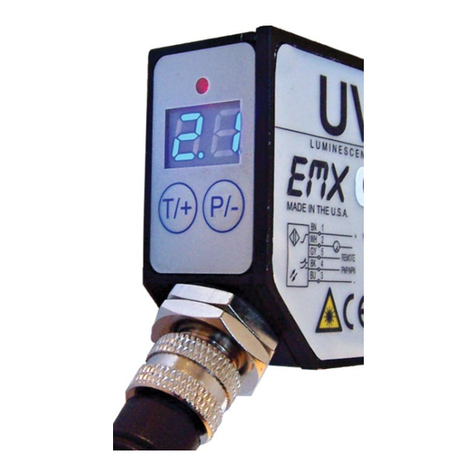
EMX Industries
EMX Industries UVX-600G-C User manual
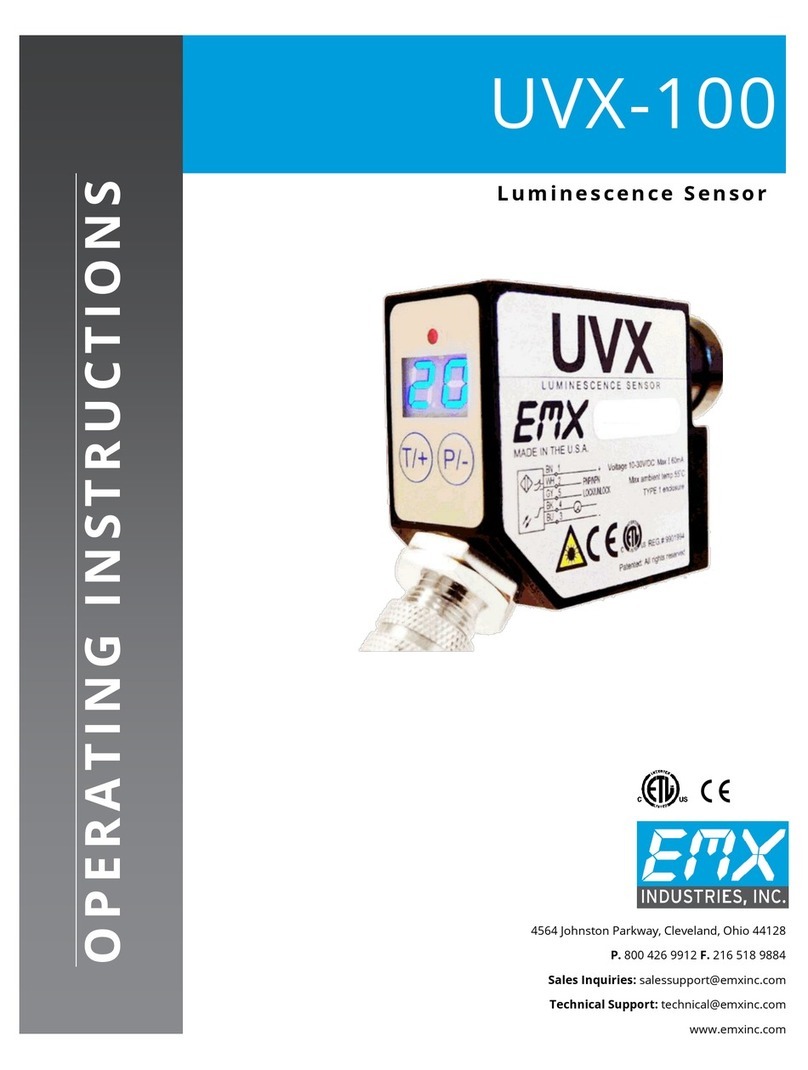
EMX Industries
EMX Industries UVX-100 User manual
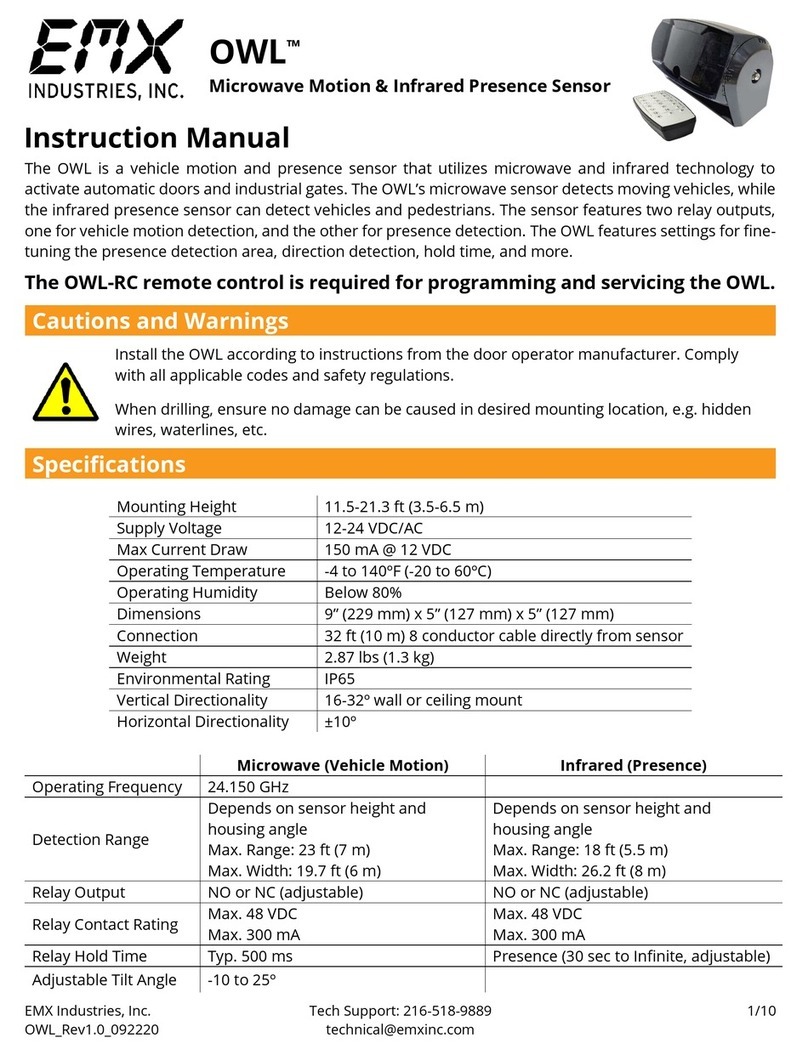
EMX Industries
EMX Industries OWL User manual
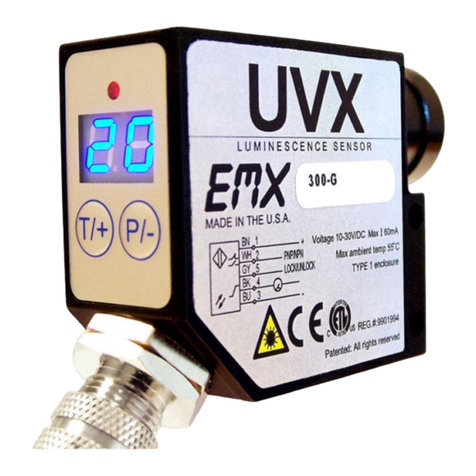
EMX Industries
EMX Industries UVX-300G User manual
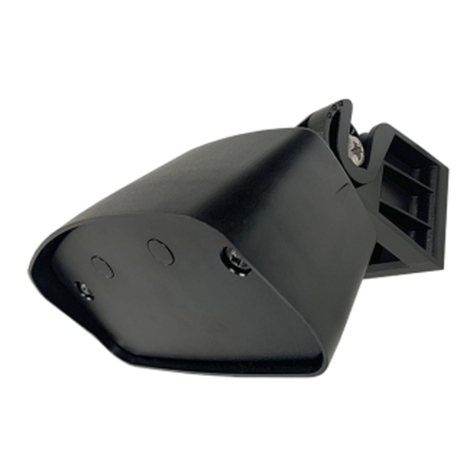
EMX Industries
EMX Industries RAVEN User manual
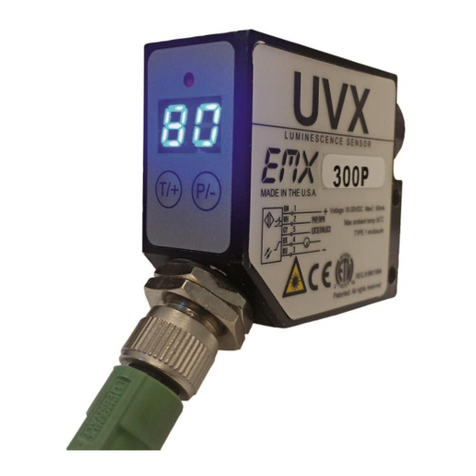
EMX Industries
EMX Industries UVX-300P User manual
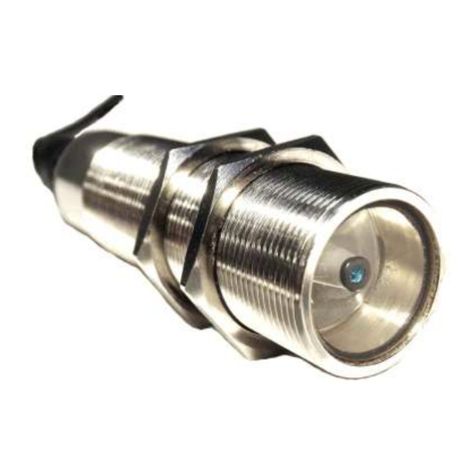
EMX Industries
EMX Industries ColorMax CM1000-1-4 User manual
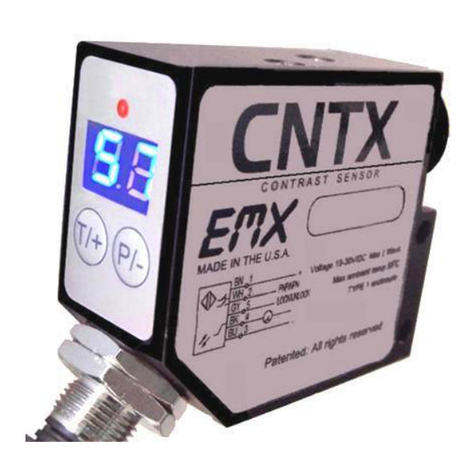
EMX Industries
EMX Industries CNTX Series User manual
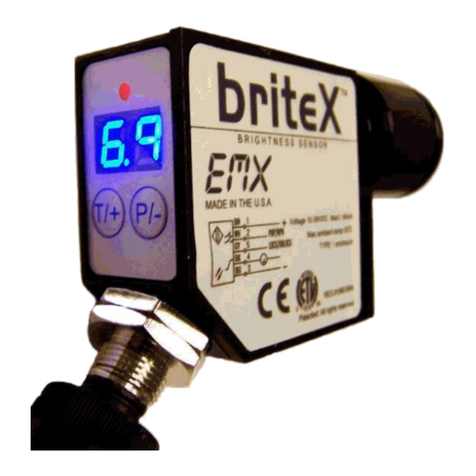
EMX Industries
EMX Industries BriteX 1000P User manual

EMX Industries
EMX Industries UVX-300G-C User manual
